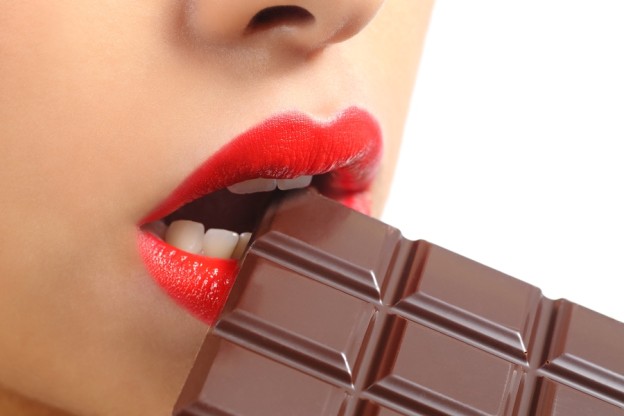By David Blyweiss, M.D., Advanced Natural Wellness
January 15, 2020
Every once in a while, I’ll get an irresistible craving for chocolate. So, I head to my freezer and pull out my favorite little bag of Ghirardelli dark chocolate squares with raspberry.
I peel off the foil wrapper and nibble slowly around the edges of the square, letting the chocolate slowly melt on my tongue. Then, I bite into the delicious and gooey raspberry center.
Just one or two of these little delights is really all I need to make my craving go away.
Now, some people will tell you food cravings are caused by underlying nutritional deficiencies. For example, you may have heard if you’re low on magnesium you’ll crave chocolate because it contains magnesium.
Well, if this theory were true, why would you crave chocolate over foods with a much higher magnesium content… like nuts, seeds and beans?
Open your arteries, improve blood flow for a new health miracle...
Did you know your circulatory system has over 60,000 miles of arteries, veins and other blood vessels, if stretched end to end?
But as you age, your blood vessels undergo changes, which may cause them to stiffen, thicken and get clogged.
GOOD NEWS! Doctors have now identified a “Miracle Molecule” inside your arteries that helps OPEN your arteries and IMPROVE blood flow.
It’s what Dr. Valentin Fuster calls it, "One of the most important discoveries in the history of cardiovascular medicine."To you, that means...
- Healthy blood pressure
- Sharper mind and memory
- Skyrocketing energy and muscular strength
- Increased pleasure and passion in the bedroom
- Improved circulation to every cell and organ in your body
Go here to discover a new natural way to significantly boost the levels of this miracle molecule in YOUR body NOW!
The fact is, science has largely debunked the idea that cravings are linked to low levels of specific nutrients.
But if that’s not the problem, how come you sometimes crave foods you know you shouldn’t eat?
The answer may lie in the most unexpected place… your gut.
You see, there are about 100 trillion microorganisms living in your intestinal tract. These bacterial cells are collectively known as your gut microbiome. And they’re able to activate nerve signals that link your stomach and your brain – a phenomenon known as the “gut-brain axis”.
But I’ve got a real eye-opener in store for you.
It turns out your gut microbiome has the power to influence the types of food you crave. And if you don’t obey, those microbes can send out signals to make you feel distressed or uncomfortable until you satisfy their craving.
The World's Quickest Solution for Ending Prostate and Urinary Misery
This has recently been revealed to be one of the only real breakthroughs in prostate health.
The seeds of a strange fruit (sometimes called "Chinese Apples") hold powerful phytonutrients that are a revolution in prostate health.
In fact, UCLA and Veterans Administration research have now proved this to be true.
Not only that, but it may be the worlds quickest solution for ending prostate misery.
Simply stated, these phytonutrients represent a huge step beyond beta sitosterol, saw palmetto, and other phytosterols alone.
Simply click HERE if you want to have fast prostate relief...restful, uninterrupted sleep...no more constant "urges to go"...enhanced virility...and optimal prostate support for life.
As if that’s not bad enough, these sly little bugs appear to be able to change your taste receptors to make the food “they” want more appealing to you. They can even hijack your vagus nerve, which regulates your eating behavior and body weight.
I once saw a cartoon of a half-asleep man walking to his fridge for the last piece of black forest cake. Drawn on the man’s stomach was a little cartoon yeast who was gleefully controlling his human host.
It’s like you have a “Mini-Me” living in your gut… one that’s intentionally sabotaging your eating habits.
Now, here’s the thing… your gut is a war zone.
All of those microbes are fighting for the same space. So the more you feed the junk-food-craving bacteria, the larger their population will grow. This, of course, will do nothing more than fuel your desire to eat even more of these unhealthy foods.
The best thing you can do for yourself is cut off their supply of fuel. Then, your longing for sugars, sweets and fats will diminish.
Amazingly, you can start changing the composition of your gut bacteria in as little as 24 hours. The idea, of course, is to eat foods that promote microbes that like to chow down on healthier foods.
And there’s a surprisingly easy way to do that.
First, it’s important to add more fermented foods to your diet. They’ll help increase the population of good bacteria in your microbiome.
Chief on the list is a Korean dish known as Kimchi. This is a spicy concoction made using fermented vegetables like cabbage, radishes and hot peppers. I also like kombucha, a fermented tea made by adding bacteria and yeast to tea and sugar.
Other fermented foods that can have a positive effect on your gut microbiome include miso, natto, kefir, tempeh and sauerkraut (homemade is absolutely the best).
Adding more prebiotic foods is just as essential. These foods nourish the good bacteria that are already in your gut. Some good prebiotic foods include Jerusalem artichoke (sunchokes), jicama (Mexican yam), bananas, and raw garlic, leeks and onions.
Then, try to increase your intake of healthy fats. This will help lower your cravings for sugar — it usually takes about two weeks to notice a change. It’s one reason why I use dark chocolate squares rather than sugary milk chocolate to satisfy my cravings.
Last but not least, supplement with a probiotic to replenish healthy bacteria in your gut. Look for a formula that contains a prebiotic along with lactobacillus, bifidobacteria and other strains of healthy bacteria. The higher the colony count, and the more live strains involved, the better off you’ll be. Just make sure to take it daily with food.
I also suggest eating a diet high in fruits and vegetables, which are associated with a highly diverse microbiota. At the same time, keep animal products to a minimum, as they can promote the growth of unhealthy gut bacteria that can stir up those cravings again.
Sources:
SOURCE: Joe Alcock, et al. Is eating behavior manipulated by the gastrointestinal microbiota? Evolutionary pressures and potential mechanisms. Bioessays. 2014 Oct; 36(10): 940–949.







